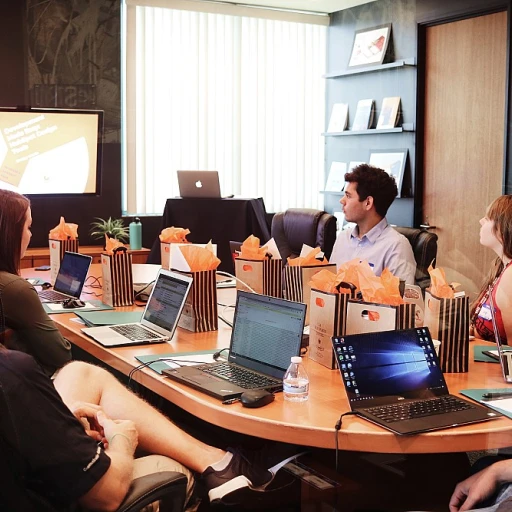
Understanding Competency Management Systems
Grasping the Essentials of Competency Management Systems
Understanding competency management systems is pivotal for organizations looking to enhance their workforce's agility. At its core, a competency management system is a platform designed to align employee skills and competencies with the evolving demands of the job market. This alignment is more critical than ever, as organizations strive to remain competitive and foster employee development.
A competency management system typically incorporates various management software tools, including talent management, performance management, and learning management systems, to streamline the assessment and improvement of employee performance. These systems help in identifying competency gaps, ensuring the workforce is consistently trained and aptly prepared for their job roles.
One of the standout features of a competency framework is its ability to offer a structured approach to skill development and succession planning. It provides organizations with a comprehensive gap analysis to pinpoint skills gaps within their workforce. Consequently, this enables the implementation of targeted training programs that are user-friendly and effective in fostering the desired competencies.
Moreover, competency management systems are frequently enhanced through the integration of cloud-based solutions. This integration facilitates seamless updates and access to crucial data across various locations, promoting a cohesive approach to employee development. With a competency framework in place, organizations can more accurately track progress and adjust their strategies to meet their unique needs.
To delve deeper into the impact of these systems on fair compensation practices within training processes, check out this article on the role of internal equity in reskilling.
The Importance of Reskilling in Today's Job Market
Reskilling: Navigating Today's Dynamic Job Landscape
In an ever-evolving job market, the significance of reskilling cannot be overstated. As industries rapidly transform due to technological advancements and shifting economic demands, organizations face the pressing need to keep their workforce adaptable and competitive. Competency management systems play a pivotal role in this transformation, guiding employees through a structured journey of learning and growth. With the advent of these systems, reskilling enables employees to acquire new skills and adjust to evolving job roles. This is not just about enhancing existing competencies but also about fostering a culture of continuous learning. Such a culture is crucial in today's market, where job roles are increasingly fluid and inter-disciplinary. There are several key reasons why reskilling is essential in managing talent:- Bridging Skills Gaps: With the help of competency management software, organizations can perform a detailed gap analysis. This helps in pinpointing where the current skill set of employees falls short, allowing targeted development initiatives.
- Boosting Employee Performance: A well-implemented training program aligned with workforce needs can significantly boost employee performance. By addressing competency gaps, employees become more efficient and fulfill their roles with confidence.
- Facilitating Succession Planning: Reskilling ensures that organizations have a robust pipeline of talent ready to take on future leadership roles. This proactive approach to talent management is critical in sustaining competitive advantage.
- Adapting to Technological Changes: As digital transformation trends continue to reshape industries, the ability to rapidly adapt is imperative. Competency frameworks tailored to these changes ensure that training programs remain relevant and effective.
- Increasing Workforce Agility: Employee skills need to be versatile in adapting to change. Encouraging an adaptive mindset can help soften the impact when organizations undergo changes.
Identifying Skills Gaps with Competency Management
Navigating Skill Gaps with Competency Management
Understanding and identifying skill gaps within an organization is a pivotal step in leveraging a competency management system. These systems not only aid in highlighting deficiencies in employee skills but also empower organizations to proactively address them. With robust competency frameworks, companies can comprehensively map the current skill set of their workforce against the competencies required for various job roles.
Utilizing competency management software, organizations embark on a journey of assessing these gaps through systematic analysis. A detailed gap analysis facilitates targeted learning and development efforts by pinpointing where employees may need additional training or reskilling. This is crucial for aligning individual and organizational capabilities with market demands.
Competency frameworks serve as the backbone of this process, enabling a structured approach to managing talent and enhancing employee performance. They provide clarity not only in job roles but also in succession planning strategies, ensuring the organization is prepared for future shifts. Importantly, these systems are designed to be user friendly, offering seamless integration with existing talent management and performance management systems.
Cloud-based platforms offer even greater flexibility, allowing for real-time updates and accessibility from anywhere. This means organizations can continuously monitor and manage competency gaps, adapting to the ever-changing landscape of workforce development.
By accurately identifying skill deficiencies and using strategic development objectives, organizations enhance their workforce agility, ensuring they remain competitive and resilient in the evolving job market.
Implementing a Competency Management System
Steps to Implement a Competency Management System
Implementing a competency management system can significantly improve an organization's workforce by ensuring that employees have the necessary skills to meet evolving job demands. Here are a few strategic steps to effectively integrate this system into your organizational framework:- Assess Your Organizational Needs
- Define Competency Frameworks
- Select the Right Software Platform
- Engage Employees in the Process
- Monitor and Evaluate Impact
Measuring the Impact of Reskilling Initiatives
Evaluating the Success of Reskilling Programs
Measuring the impact of reskilling initiatives is crucial for organizations aiming to enhance their workforce agility. A competency management system plays a pivotal role in this evaluation process by providing a structured framework to assess employee performance and development.
Key Metrics for Assessment
To effectively measure the success of reskilling efforts, organizations should focus on several key metrics:
- Employee Performance: Track improvements in employee performance post-training. This can be done through performance management systems that align with the competency frameworks established.
- Skill Gaps Reduction: Use gap analysis to identify reductions in competency gaps. This helps in understanding how well the reskilling initiatives are addressing the identified skill gaps.
- Job Role Adaptability: Assess how well employees adapt to new job roles or responsibilities, indicating the effectiveness of the training programs.
- Employee Engagement: Monitor employee engagement levels as a result of reskilling. Engaged employees are more likely to apply new skills effectively.
Utilizing Technology for Impact Measurement
Advanced management software and platforms offer user-friendly tools to track and analyze the impact of reskilling initiatives. These systems provide insights into employee skills development and help in succession planning by identifying potential talent within the organization.
Continuous Improvement and Feedback
Feedback loops are essential for continuous improvement. Organizations should regularly collect feedback from employees about the training programs and use this data to refine their reskilling strategies. This iterative process ensures that the competency management system remains aligned with the evolving needs of the workforce.













